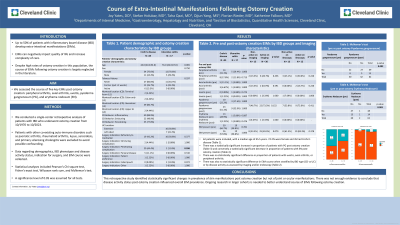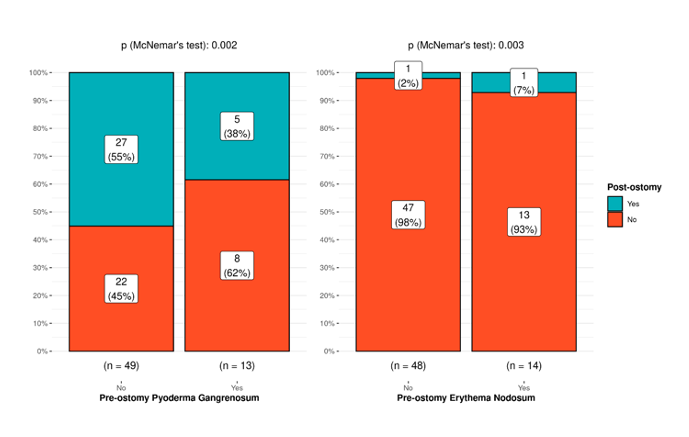Sunday Poster Session
Category: IBD
P0948 - Course of IBD Extra-Intestinal Manifestations Following Ostomy Construction
Sunday, October 27, 2024
3:30 PM - 7:00 PM ET
Location: Exhibit Hall E

Has Audio

Joy Yates, DO
Cleveland Clinic Foundation
Cleveland, OH
Presenting Author(s)
Joy Yates, DO1, Stefan Holubar, MD2, Taha Qazi, MD3, Qijun Yang, MS2, Florian Rieder, MD4, Katherine Falloon, MD5
1Cleveland Clinic Foundation, Cleveland, OH; 2Cleveland Clinic, Cleveland, OH; 3Cleveland Clinic Foundation, Beachwood, OH; 4Digestive Diseases and Surgery Institute; Lerner Research Institute, Program for Global Translational Inflammatory Bowel Diseases; Cleveland Clinic Foundation, Cleveland, OH; 5Cleveland Clinic Foundation, Shaker Heights, OH
Introduction: Up to 50% of patients with inflammatory bowel disease (IBD) develop extra-intestinal manifestations (EIMs), which can negatively impact quality of life and increase complexity of care. Despite high rates of ostomy construction in this population, the course of EIMs following ostomy creation has been largely neglected in the literature. In this study, we assessed the course of five key EIMs after ostomy creation: peripheral arthritis, axial arthritis, uveitis, pyoderma gangrenosum (PG), and erythema nodosum (EN).
Methods: We performed a retrospective analysis of patients with IBD who underwent ostomy construction between October 1970 to October 2023. Patients with other coexisting autoimmune disorders (psoriatic arthritis, rheumatoid arthritis, lupus, sarcoidosis, or primary sclerosing cholangitis) were excluded to avoid possible confounding factors. Data regarding demographics, IBD phenotype and disease activity status, indications for surgery, and EIM course were collected. Statistical analyses included Pearson’s chi-square test, Fisher’s exact test, Wilcoxon rank-sum test, and McNemar’s test.
Results: The study included 62 patients (median age 45.5 years, 74.2% female, 45 (72.6%) Crohn’s disease). We observed a statistically significant increase in the proportion of patients with PG post-ostomy construction (p=0.002) and conversely a statistically significant decrease in proportion of patients with EN post-ostomy construction (p=0.003). However, there was no significant difference in the proportion of patients with uveitis, axial arthritis, or peripheral arthritis. There was also no statistically significant difference in EIM course when compared by IBD type (CD vs. ulcerative colitis) or disease activity assessed by imaging and/or endoscopy.
Discussion: This retrospective study identified statistically significant changes in prevalence of skin manifestations post-ostomy construction but not of joint or ocular manifestations. There was not enough evidence to conclude that disease activity status post-ostomy construction influenced overall EIM rates. Ongoing research in larger cohorts is needed to better understand the course of EIMs after ostomy creation.

Note: The table for this abstract can be viewed in the ePoster Gallery section of the ACG 2024 ePoster Site or in The American Journal of Gastroenterology's abstract supplement issue, both of which will be available starting October 27, 2024.
Disclosures:
Joy Yates, DO1, Stefan Holubar, MD2, Taha Qazi, MD3, Qijun Yang, MS2, Florian Rieder, MD4, Katherine Falloon, MD5. P0948 - Course of IBD Extra-Intestinal Manifestations Following Ostomy Construction, ACG 2024 Annual Scientific Meeting Abstracts. Philadelphia, PA: American College of Gastroenterology.
1Cleveland Clinic Foundation, Cleveland, OH; 2Cleveland Clinic, Cleveland, OH; 3Cleveland Clinic Foundation, Beachwood, OH; 4Digestive Diseases and Surgery Institute; Lerner Research Institute, Program for Global Translational Inflammatory Bowel Diseases; Cleveland Clinic Foundation, Cleveland, OH; 5Cleveland Clinic Foundation, Shaker Heights, OH
Introduction: Up to 50% of patients with inflammatory bowel disease (IBD) develop extra-intestinal manifestations (EIMs), which can negatively impact quality of life and increase complexity of care. Despite high rates of ostomy construction in this population, the course of EIMs following ostomy creation has been largely neglected in the literature. In this study, we assessed the course of five key EIMs after ostomy creation: peripheral arthritis, axial arthritis, uveitis, pyoderma gangrenosum (PG), and erythema nodosum (EN).
Methods: We performed a retrospective analysis of patients with IBD who underwent ostomy construction between October 1970 to October 2023. Patients with other coexisting autoimmune disorders (psoriatic arthritis, rheumatoid arthritis, lupus, sarcoidosis, or primary sclerosing cholangitis) were excluded to avoid possible confounding factors. Data regarding demographics, IBD phenotype and disease activity status, indications for surgery, and EIM course were collected. Statistical analyses included Pearson’s chi-square test, Fisher’s exact test, Wilcoxon rank-sum test, and McNemar’s test.
Results: The study included 62 patients (median age 45.5 years, 74.2% female, 45 (72.6%) Crohn’s disease). We observed a statistically significant increase in the proportion of patients with PG post-ostomy construction (p=0.002) and conversely a statistically significant decrease in proportion of patients with EN post-ostomy construction (p=0.003). However, there was no significant difference in the proportion of patients with uveitis, axial arthritis, or peripheral arthritis. There was also no statistically significant difference in EIM course when compared by IBD type (CD vs. ulcerative colitis) or disease activity assessed by imaging and/or endoscopy.
Discussion: This retrospective study identified statistically significant changes in prevalence of skin manifestations post-ostomy construction but not of joint or ocular manifestations. There was not enough evidence to conclude that disease activity status post-ostomy construction influenced overall EIM rates. Ongoing research in larger cohorts is needed to better understand the course of EIMs after ostomy creation.

Figure: Figure 1. Pre- and post-ostomy pyoderma gangrenosum and erythema nodosum
Note: The table for this abstract can be viewed in the ePoster Gallery section of the ACG 2024 ePoster Site or in The American Journal of Gastroenterology's abstract supplement issue, both of which will be available starting October 27, 2024.
Disclosures:
Joy Yates indicated no relevant financial relationships.
Stefan Holubar: Takeda – Advisor or Review Panel Member.
Taha Qazi: Abbvie Biosciences – Advisor or Review Panel Member, Consultant, Grant/Research Support, Speakers Bureau. Celgene/BMS – Advisor or Review Panel Member, Speakers Bureau. Janssen – Speakers Bureau. Pfizer – Advisor or Review Panel Member, Advisory Committee/Board Member. Prometheus Biosciences – Advisor or Review Panel Member, Advisory Committee/Board Member, Consultant.
Qijun Yang indicated no relevant financial relationships.
Florian Rieder: 89Bio – Consultant. AbbVie – Consultant, Grant/Research Support. Adiso – Consultant. Adnovate – Consultant. Agomab – Consultant. Allergan – Advisory Committee/Board Member, Consultant. Arena – Advisory Committee/Board Member, Consultant. AstraZeneca – Advisory Committee/Board Member, Consultant. Bausch & Lomb – Consultant. Boehringer Ingelheim – Advisory Committee/Board Member, Consultant, Grant/Research Support. CDISC – Consultant. Celgene/BMS – Advisory Committee/Board Member, Consultant, Grant/Research Support. Celltrion – Consultant. Celsius – Consultant. Cowen – Consultant. Eugit – Consultant. Ferring – Consultant. Galapagos – Consultant. Galmed – Consultant. Genentech – Advisory Committee/Board Member, Consultant. Gilead – Advisory Committee/Board Member, Consultant, Grant/Research Support. Gossamer – Consultant. Granite – Consultant. Guidepoint – Consultant. Helmsley – Consultant. Horizon Therapeutics – Consultant. Image Analysis Limited – Consultant. Index Pharma – Consultant. Jannsen – Consultant. Koutif – Consultant. Landos – Consultant. Mestag – Consultant. Metacrine – Consultant. Mirum – Consultant. Mopec – Consultant. Morphic – Consultant. Myka Labs – Consultant. Organovo – Consultant. Origo – Consultant. Palisade Bio – Consultant. Pfizer – Advisory Committee/Board Member, Consultant, Grant/Research Support. Pliant – Consultant. Prometheus Biosciences – Advisory Committee/Board Member, Consultant. Receptos – Consultant. RedX – Advisory Committee/Board Member, Consultant. Roche – Advisory Committee/Board Member, Consultant. Samsung – Advisory Committee/Board Member, Consultant. Sanofi – Consultant. Surmodics – Consultant. Surrozen – Consultant. Takeda – Advisory Committee/Board Member, Consultant, Grant/Research Support. Techlab – Consultant. Teva – Consultant. Theravance – Consultant. Thetis – Consultant. Trix Bio – Consultant. UCB – Advisory Committee/Board Member, Consultant, Grant/Research Support. Ysios – Consultant.
Katherine Falloon: Janssen – Advisory Committee/Board Member. Pfizer – Grant/Research Support.
Joy Yates, DO1, Stefan Holubar, MD2, Taha Qazi, MD3, Qijun Yang, MS2, Florian Rieder, MD4, Katherine Falloon, MD5. P0948 - Course of IBD Extra-Intestinal Manifestations Following Ostomy Construction, ACG 2024 Annual Scientific Meeting Abstracts. Philadelphia, PA: American College of Gastroenterology.
